SDM NEWS 2013
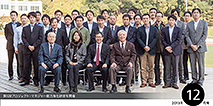 |
 Message from the Faculty Message from the FacultyNew Year's Greeting (Ken Victor Leonard Hijino, Associate Professor) Season's greetings! Here at Hiyoshi Campus, the golden crown of the maidenhair trees has been blown off by the strong wind of the previous day, making us feel the imminent arrival of winter. By the time you read this article, the new year may already have arrived. |
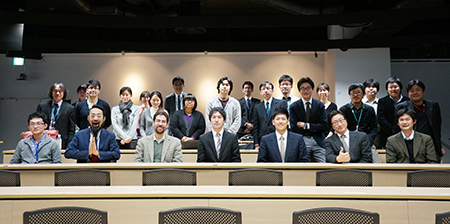 Happy New Year! Your continued support of Keio SDM in 2014 is most appreciated. Happy New Year! Your continued support of Keio SDM in 2014 is most appreciated.Looking back on 2013, it is evident that many events of great significance happened in the world, to Japan and to Keio SDM. Among the most memorable in the global context were the internet intelligence-gathering scandal of the US NSA, which was exposed by Edward Snowden, the partial shutdown of US government functions due to the confrontation over the federal budget between the ruling and opposition parties, the deaths of former Prime Minister Margaret Thatcher of Great Britain and former President of South Africa, Nelson Mandela. Additionally, a powerful typhoon struck the Philippines, causing wide-scale damage and Xi Jinping was elected General Secretary of the Chinese Communist Party. What comes to my mind as far as Japan is concerned is the commencement of Abenomics, the decision to participate in the TPP negotiations, Nippon Ishin no Kai (Japan Restoration Party) Co-leader Hashimoto's controversial remark regarding "comfort women", the Liberal Democratic Party and the New Komei's clear sweep in an election, the selection of Tokyo as host of the 2020 Olympics and the passing of the Designated Secrets Protection Bill. While all these things have happened, I am amazed by how much of it I had already forgotten before the year had ended. The thought that all these events interacted with one another in a complex and diverse manner as part of the socio-economic system of the world is overwhelming, but thrilling at the same time. The year 2013 also brought many events and news to Keio SDM. The photo above was taken after one such event - an in-class lecture by Mr. Kunikazu Suzuki, President of Nihonseiji.com. I was involved in the event and therefore remember it vividly. The audience, including myself, was deeply impressed by Mr. Suzuki's young, conscious, ambitious and sharp-minded approach to exploring solutions and taking action. With the same spirit evidenced by Mr. Suzuki, we would like to continue our endeavors in conducting research with a view to improving the complex and gigantic system in the year to come. |
|
Laboratory Profile
Science and Technology System Laboratory |
TOPICS
1. Round-Table Discussion featured in AIST's "Synthesiology" Features
2. The Fifth Project Manager Leadership Training
3. Keio SDM Information Session at Hiyoshi Campus
4. "New Story of the New Era - from an Ecologic to Cosmologic Society"
5. "Justice with Maeno & Kobayashi": Heated Dialogue on Happiness |
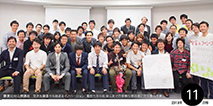 |
 Message from the Faculty Message from the FacultyWith an Eye Toward Architects of the New Era (Shinichiro Haruyama, Professor) Today, Japan embraces high-level technologies and product-development abilities. This, however, will not be enough for the future, as it is said that the innovation capabilities for changing society is more important. |
Responding to such changes, Keio SDM is focused on nurturing architects of the new era and equipping them with both system thinking, which captures the whole by taking a panoramic view, as well as design thinking, which focuses on collaboration, empathy and prototyping. At Keio SDM, we carry out various activities that are not limited to lectures and research. As we reported in our September newsletter, a business-academia collaboration team of Keio SDM and Fujitsu Computer Technologies Limited earned overall victory in the architecture sector of the ET Robot Contest 2013 (Block B, Tokyo Area), which was held in September 2013. What was particularly well received was the team's capability to develop an innovative concept and actualize this concept. Even through such an enjoyable contest, I could clearly see the increasing demand for architects who can develop new concepts. It is my hope that Keio SDM continues to produce many architects who are capable of establishing a bright future through our educational and research activities. |
|
Laboratory Profile
Architecting Laboratory |
TOPICS
1. APCOSEC 2013
2. Development of Dialogue Tools for Innovations
3. Establishment of the Model Research Group for Multi-Generational Health Project with Nagaoka City
4. Keio SDM Extension Lecture: "Brain and Big Data"
5. Keio SDM Extension Lecture, "Design Management for 'Contributing to the Society': Discussion with Keio Alumni NPO Managers at Hiyoshi"
6. Keio SDM Extension Lecture, "Innovation That Begins with a Can Satellite: The Satellite Development Contest and the Space Service Creation Workshop for Senior High School and University Students"
7. Extension Lecture by Mr. Hima Furuta
8. The Extension Lecture by Mr. Yoshihiro Kanematsu
9. Lecturer Yohei Aso, SDM Alumnus, Wins the Journal Prize in the Journal of Japan Creativity Society Vol.16, 2012
|
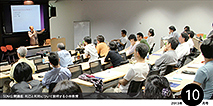 |
 Message from the Faculty Message from the FacultySystems Thinking Leads to Innovation (Masaru Nakano, Professor) The "super" Monozukuri (Japanese Art of Manufacturing) Conference, "The Model-Based Development Which Brings Innovations to the Monozukuri Industry," which we held together with Nikkan Kogyo Shimbun, Ltd. on September 6, 2013, attracted many participants from various sectors. |
I would like to take this opportunity to thank everyone who took part. This event made me realize that various sectors, such as the business community, are interested in model-based systems engineering. I think we need to focus even more on the model-based approach in our education and research activities at Keio SDM. In order to "think systems," it is important to graphically describe the relationships between the whole and its parts (modeling). Additionally, elevating the level of abstraction in examining behaviors and structures of systems can lead to innovation. By applying such an approach, we at Keio SDM will continue our efforts to tackle design and management of "system of systems" in which humans, society and technologies are all entangled in a complex way. |
|
Laboratory Profile
Business Engineering Research Laboratory
Innovative Design Center |
TOPICS
1. Symposium: "Approach to Sustainable Happiness"
2. SDM Extension Lecture, "Public Philosophy x System Design and Management: Communitarianism and Collaborative Creation"
3. International Symposium on Environmental Urban Design: Approaches of Yokohama and Northern Europe to the Future City
4. Keio SDM - ETH Zurich: Joint Interactive Seminar 2013
|
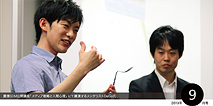 |
 Message from the Faculty Message from the FacultyEnormous Waste in the Japanese-style System (Masaru Nakano, Professor) Japan's high quality products and fine services are widely known at home and abroad. Behind these exists the mind of the Japanese people - valuing continuous efforts for improvement. |
An example would be Toyota Motor's production system philosophy - the "complete elimination of all waste" - which has received a degree of international attention. I cannot help but wonder: are "Japanese-style" systems really efficient? In fact, the efficiency of Japanese manufacturing has decreased by almost 40% over the past 30 years. Many large-scale companies are wasting an enormous amount of time on internal meetings and in producing materials for internal use. The problem of so-called "black businesses" that force employees to work long hours is also becoming serious. I have seen some cases where Japanese companies have failed in terms of business despite having technologies that they themselves developed through massive investment. Recently, I enjoyed an extended-stay in Switzerland. There, I witnessed how trams run at a pace about equal to a walking speed while company employees head home early - even on weekdays - to enjoy leisure activities, such as going on a hike and listening to music. Nevertheless, the economy seemed strong and wealthy, backed by a solid urban system. It seems that people take the time to see through to the essence of things and work efficiently in the right direction. In Tokyo, on the other hand, trains rush into platforms at high speed. It may seem as though the transportation system is convenient and efficient, but the truth may be that people are in such a state that they do not have room for thinking about systems thoroughly. There are signs that crucial issues, such as the national finances, nuclear policy and the rebuilding of the devastated Tohoku area, are frequently postponed or else put-off. There is a possibility that efforts made in improving small details at hand are instead creating massive inefficiency. I believe that it is time that Japan's social system eliminated this enormous waste by employing systems thinking, thereby transforming it into an efficient system. |
|
Laboratory Profile
Ubiquitous Communication Laboratory |
TOPICS
1. The Agricultural Laboratory Visits the Tokachi Area
2. Keio SDM Extension Lecture: Media Strategy and Human Psychology - How an Individual Moves Media
3. The 4th CanSat Leader Training Program (CLTP4) at Keio SDM
4. Business-Academia Collaboration Team Takes Overall Victory in the Architecture Sector at the ET Robot Contest 2013 (Block B, Tokyo Area)
5. Big Data Innovation Human Resource Development Program Adopted as MEXT's Project
6. Ms. Akiko Nagasawa (2nd Year Master's Student) Receives the Anita Borg Memorial Scholarship 2013: Asia-Pacific
|
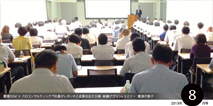 |
 Message from the Faculty Message from the FacultyThe Graduate School That Continues to Strive ー Keio SDM (Tetsuya Toma, Associate Professor) We are beginning to feel the start of autumn after a long spell of hot summer days. Despite the heat, we at Keio SDM carried out a variety of activities this summer with enthusiasm. |
It has been our pleasure to share the fruits of our efforts with you once again this month. I would like to take this opportunity to sincerely thank you all for supporting our activities.
Being part of a modern society that is changing dramatically and becoming increasingly complex, Japan is faced with various problems - natural disasters, declining birth rate combined with an aging population and diplomatic issues. Nevertheless, Japan has a solid foundation, constructed of world-class technical capabilities, a high reputation for reliability and the ability to offer the highest standard of services. In order for these qualities to flourish in the global society, we need to stop thinking in conventional ways and start applying new thinking capabilities, i.e., "System Thinking x Design Thinking," and apply innovative leadership styles that build on "collective wisdom." By responding to the changing times, Keio SDM will carry out research and educational activities to strive for capacity development that capitalizes on Japan's excellent abilities. Our annual fall event, the Project Manager Capacity Development Training Course, has also been organized in line with this approach. We look forward to your participation. |
|
Laboratory Profile
Human System Design Laboratory
Visual Simulation Laboratory (VS-Lab) |
TOPICS
1. Keio SDM Information Session
2. Seminar on "Corporate and Organizational Designs that Enable Employees to Actively Produce Results" by Keio SDM × iTiD Consulting
3. Heated Dialogue: "Public Philosophy × System Design and Management - Integration of Eastern and Western Perspectives of the World"
4. Lecture Series: "Space School"
5. First Year Doctoral Student, Mr. Sugimoto, Featured in ZERO Human of NEWS ZERO
|
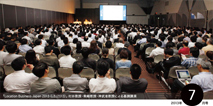 |
 Message from the Faculty Message from the FacultyWelcome to the Graduate School of New Concepts (Ryuichi Teshima, Professor) I am Ryuichi Teshima; I teach Intelligence Systems at the Graduate School of System Design and Management, Keio University (Keio SDM). |
I have been advocating the importance of midterm careers since the time I worked as Chief of the Japan Broadcasting Corporation (NHK)'s Washington Bureau. There is an expression -- the "slash-and-burn cultivation" of journalists, trading company employees and bureaucrats. It refers to the act of corporations and organizations overusing energetic young people. As soon as the young employees burn out, these organizations recruit new ones only to exploit them until they too are worn out. Although such practices may be convenient for organizations, they certainly are not fair to young people. Life is invaluable. At times we need to stop to replenish our intellectual tanks and steer ourselves in a new direction. In Japan where many people still cling to the idea of lifetime employment, people rarely take short breaks in the middle of their careers to satisfy their intellectual appetite, although it is a common practice outside Japan. Keio SDM is a graduate school that supports challengers. Together with young people who share our passion for changing the way society is, we face new challenges every day at Keio SDM. |
|
Laboratory Profile
Communication Design Laboratory
Comparative Political Systems Laboratory |
TOPICS
1. Keio SDM Special Lecture: 'Thus Far' and 'From Now On' for the Tree of Life
2. Deciphering the Situation in Northeast Asia using Intelligence: The Coalition Against North Korea and the Moves of the US, China, Japan, Russia and Korea
3. Serialization in Nikkei Monozukuri of Nikkei BP Ends
4. Heated Dialogue: Public Philosophy x SDM
5. Mr. Hoya (2nd year Master's course) Receives the "Broadcasting Culture Fund Prize", "Japan Commercial Broadcasters Association Prize" and the "Technology and Development Prize" of the Motion Picture and Television Engineering Society of Japan
6. Location Business Japan 2013 (LBJ2013)
7. Symbiotic System Design Laboratory and AGRI Laboratory Researcher Opens a Store in CHABARA, a New Shopping Complex
|
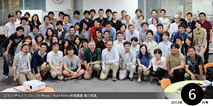 |
 Message from the Faculty Message from the FacultyJapanese-Style Corporate Management for the 21st Century (Kenichi Takano, Professor) These days, Japan's economy is regaining its strength. Despite this hopeful sign, the proportion of people employed on a contractual basis has reached 35% and continues to increase. |
Securing a regular position in an organization has become difficult for job seekers, which includes new graduates. It is a situation that is not improving and many people continue to struggle in a turbulent job market. I recently read Black Business: The Monster Devouring Japan. "Black business" refers to companies that overwork their employees by taking advantage of the so-called "Japanese corporate style". These firms shamelessly treat young employees as if they were disposable. The book reveals disturbing facts about what companies do and how they do it; constant discrimination and harassment, as well as devious ways of driving "losers" out of the companies. In the past, corporations anchored the high-growth era of Japan by securing long-term employment based on paternalistic management. In this environment, employees demonstrated high moral standards and loyalty. However, now that Japan finds itself in a low-growth era, it may be difficult for companies to employ traditional Japanese management styles, considering the constant fear of international competition and crises. Nevertheless, one should realize that it is not the level of salaries that determines motivation, self-realization and a sense of accomplishment. Rather, it is the philosophy and management abilities of the company. With an aim at bringing innovation to the cultures and climates of organizations, the Organizational Management Laboratory has been researching ways for utilizing group dynamics, such as enhancing teamwork and leadership, and encouraging all company members to have shared values. One research finding has been particularly interesting. The results of a questionnaire survey targeting more than four thousand white-collar employees indicate that an organizational climate described by the three axes of "cooperation", "challenge" and "contribution" has a strong correlation with the aspects "job satisfaction" and "performance". This suggests that companies would be able to establish a good culture and climate if they improved and shared values (e.g. cooperation, challenge and contribution). By doing so, corporations will be able to keep up with international competition while preserving the Japanese style of management in a true sense, unlike the "black business" approach mentioned above. |
|
Laboratory Profile
Symbiotic System Design Laboratory
Control Systems Design and Dynamics Laboratory |
TOPICS
1. Keio SDM Information Session, Class & Facility Visits and Poster Session
2. Purdue University Group Visits Keio SDM
3. Progress Report on the Design Project
4. Workshop in Fukushima: The Super Science High School
5. Realizing Vision: "Achieving a Society Filled with Children's Smiles and a Good Circle of Growth"
Notice : Announcement: APCOSEC 2013
|
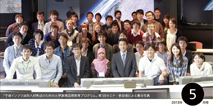 |
 Message from the Faculty Message from the FacultyIntegrated Approach Covering the Entire Life Cycle (Seiko Shirasaka, Associate Professor) Since its foundation, Keio SDM has been evolving around the systems approach based on systems engineering. |
One year ago, in the May 2012 issue, I wrote about realizing SDM Studies as an integrated and overarching academic discipline, which can deal with various systems, from technological to social, in a unified manner. The emergence of SDM Studies implies that systems approach is increasingly applied to a wider range of fields. This can be seen in the fact that many individuals from various companies, universities, and institutions have been attending sessions at Keio Systems School, which was launched in January 2013. On the other hand, I am also realizing that the systems approach is increasingly applied to a wider phase. That is to say, there is an emergence of a methodology whereby one can attain innovative solutions more surely by applying the unique method--a combination of system thinking and design thinking--from the beginning of a life cycle. This year, I am eager to attain results by applying an integrated approach. |
|
Laboratory Profile
Intelligence System Laboratory
Smart System Design Laboratory |
TOPICS
1. Extension Lecture and Keio SDM Information Session
2. PMP® Preparation Course at Management Design Center
3. The 2013 Entrance Ceremony and Introductory Camp
4. The 4th Keio Systems School Workshop, System Architecting Workshop:
"Capture All Things Using Architecture and Create Architecture of Everything" 5. Extension Lecture by Professor Jan Peter Balkenende, Former Prime Minister of the Kingdom of the Netherlands
6. "Space School"-- Extension Lecture by Astronaut Hoshide
7. The 1st Seminar of the International Education Program on Nurturing Human Resources for Space Infrastructure Utilization
|
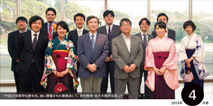 |
 Message from the Faculty Message from the FacultySakura a Millennium Later (Shoichi Sasaki, Professor) The cherry blossoms or sakura this year bloomed and fell in the blink of an eye. Each year, as spring comes around, I remember the Fukushima Daiichi Nuclear Plant disaster. As a result of its releasing massive radioactive substances, many residents and workers were forced to relocate. |
It is unfortunate that in the course of the evacuation and relocation many people came to the end of their lives earlier than expected. It seems to me that the first cause of the disaster was the assumption that there would be no accident as long as the national safety standard was complied. Or was it that, Tokyo Electric Power Company (TEPCO) thought that they could blame it on the government as they were responsible for setting the security standard in case there was an accident? Although it is difficult to judge, I believe it was an intentional act of the past managers of TEPCO, whatever the case. Another cause of the disaster may have been that we, including myself, failed to weigh the risks and benefits of nuclear power. Some argue that it is beneficial to utilize nuclear power for the sake of securing industrial competitiveness because they are cheap and "reasonably" safe--in the sense that they would not do direct harm to them. Others argue that nuclear power plants must be abandoned for the sake of future generations due to the potential they have to cause catastrophes such as that of Fukushima. I believe it is our duty to analyze the risks and benefits of both arguments based on common data and to reflect the results of such analysis in the country's decision making process through elections and other forums. Recently the Japanese government is showing its stance as it considers resuming the operation of the nuclear power plants which have been confirmed as safe. On the other hand, safety can only be "ensured" based on a certain projected scale of earthquakes and tsunamis. This means that one cannot "confirm" safety in general terms unless it can be proved that unexpected situations will never occur. These are indeed the preconditions on which we should keep a close eye. Another issue is how to address the risks of meteorite impacts and terrorism. As for a meteorite impact, it is up to us to determine whether or not to prepare ourselves for the risk: We can place power plants deep enough to prepare for the risk of meteorites; we can conclude that it is the kind of risk we cannot avoid and choose not to be prepared; or we can choose not to consider it as a risk factor at all. With regard to terrorism, while we rely on the police and the self defense force, whether or not we can counter terrorism in reality depends on our defense capabilities and technologies. For example, if the terrorists have missile technology capable of hitting a target ten consecutive times, we should then have surface-to-air missile defense capabilities that can hit more than ten consecutive times. The problem is, however, we do not know how much defense capability would be sufficient. As such, we are posed with these kinds of questions. Lastly, in good humor, how about allocating the responsibility of final disposal of radioactive waste generated through nuclear power generation in proportion to the accumulated electricity usage of each prefecture? This will at least visualize how much burden we would have to bear. If we pass the responsibility on to future generations, it is our obligation to sufficiently understand what nuclear waste management entails. Sakura of a millennium ago was greatly cherished by Heian aristocrats. I believe that a thousand years from now sakura will also wish to be cherished by humanity. We shall keep in mind that our judgments of today will determine the fate of a millennium from now. |
|
Laboratory Profile
Management Design Center
System Design Methodology Laboratory |
TOPICS
1. The 4th OPEN KiDS Workshop: "Design Workshop for Locality and Community Vitalization"
2. The Fifth Symposium for Safe, Secure and Symbiotic System Design: "Brain, Heart, and Happiness"
3. International Education Program Launched: Nurturing Human Resources for Space Infrastructure Utilization
4. The Third Session of Keio Systems School: "Think about Systems--Model-Based Systems Engineering Workshop"
5. Extension Lecture, "The Future of Dialogue and Design Vol. 9: The Future of Movies"
6. Three SDM Students Start Up a Company: "RIS Design and Management"
7. Commencement 2012
8. Team of Project Lecturer Makino Receives the Honorable Mention Demonstration Award at IEEE International Conference on Human-Robot Interaction 2013 |
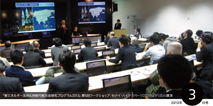 |
 Message from the Faculty Message from the FacultyKeio SDM Going Global (Naohiko Kohtake, Associate Professor) Two years have passed since the Great East Japan Earthquake. Recovery from the disaster has been one of Japan's top priorities; and Keio SDM students, alumni, and faculty are dealing with the large and complex issues of the recovery in diverse ways. |
Natural disasters of various kinds have occurred in many parts of the world since the Great East Japan Earthquake, including earthquakes, tsunamis, heavy rainfall, floods, and wildfires. In fact these all prove that the earth is living and active and that we cannot avoid natural disasters as long as we live here. Natural disasters are borderless. Consequently, we humans need to think and act beyond national boundaries in order to face these challenges. A first step forward is to endeavor to interact with people of various countries to deepen mutual understanding. In fact many of the international projects in which Keio SDM is involved are successful, thanks to the "key persons" within the partner institutions who have a good understanding of Japan, Keio, and/or Keio SDM. I believe that the key to dealing with different large-scale and complex challenges is to form a sustainable and global network. To do so, each one of us, students and faculty of Keio SDM, must act as a representatives of Japan in interacting with persons of various nations and regions, thereby deepening the mutual understandings and act as intermediary to sustain these relationships. Celebrating its fifth anniversary, Keio SDM will launch new exchange programs with University of Cambridge, Massachusetts Institute of Technology, and the University of Adelaide in April. With more global partners, Keio SDM will strive to solve problems and contribute to society through education and research pertaining to the systems approach. |
|
Laboratory Profile
Laboratory of Organizational Management (MOBIL)
Next Generation Contents Laboratory |
TOPICS
1. "The Future of Dialogue and Design Vol. 8: The Future of the Economy"
2. Extension Lecture: "Design the Social System"
3. TOEFL-ITP for SDM Students
4. "Regional Vitalization Workshop Using Charm-Plus Card of Kohoku Ward"
5. The Fifth Workshop on "Utilization of New Energy and Sustainable Social Research Program 2013" |
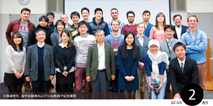 |
 Message from the Faculty Message from the FacultyBuilding System-Oriented Nation Based on Science and Humanities (Tetsuro Ogi, Professor) It has been a while since science, as opposed to the humanities, lost its popularity among students in Japan. |
Considering that science and technology have been the driving force behind the nation's prosperity, I am afraid that this phenomenon could lead to the deterioration of Japan's national strength. Science and technology-related subjects, such as mathematics and physics, require students to patiently accumulate knowledge. This may be one of the reasons why students find it difficult to visualize whether what they are studying will be of any use. The same is true for university-level research. Some students study component technology without really understanding how that particular technology can be applied or how it will fit into the bigger picture. This is an example of failing to see the whole picture as a system. I believe that the study and research of science will be more interesting if one tries to see where a particular knowledge is leading to and how the technology can be applied. At Keio SDM we do not distinguish science from the humanities. Rather, we promote the education of system design, integrating science and the humanities. Students are encouraged to see the bigger picture based on scientific thinking while dealing with a wide range of issues, from detail technology to applied business, based on thought from both science and the humanities. I believe that education as such will make Japan more system-oriented, thereby contributing to building a stronger nation. |
|
Laboratory Profile
Regional Development and Vitalization Laboratory
Spatial Location-Based Service Laboratory |
TOPICS
1. Keio Innovative Design School (KiDS) Workshop
2. Keio SDM Extension Lecture, "Workshop on Systems: Taking Panoramic View of All Things for Systematic Execution"
3. Keio SDM Extension Lecture, "Tips for Reaching Hearts: Proposals to Win the Hearts and Minds of People"
4. Debriefing and Informational Session for Study Abroad/Exchange Programs
|
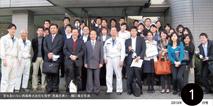 |
 Message from the Director and Dean Message from the Director and DeanSolving Problems with the "Systemic x Systematic" Approach (Takashi Maeno, Director, SDM Research Institute Dean) A Happy New Year! Keio SDM's catch-word for this year is "system." As we mainly featured "design" last year, we will go back to the basics and focus on "system" this year. |
A system is something that is created from relationships between elements. Anything that contains interactions, from technological interactions to social and human interactions, is a system. At Keio SDM we place emphasis on "systems approach" which is based upon systems engineering. There are two meanings to the systems approach: one is systemic approach; and the other is systematic approach. The former urges us to take a panoramic view of things as a system; while the latter guides us to decompose and integrate things logically. Keio SDM utilizes both of these approaches so as to pursue innovative design and sustainable management. Our mission is to nurture human resources who understand the systems approach, to conduct practical research concerning the basics and applications of SDM Studies, and to solve problems for social change by collaborating with different entities on various levels. We will continue our endeavor to create a better world this year. Your continued guidance and support are greatly appreciated. The SDM News will feature messages from the faculty on the first page again this year. Twelve supervising Professors/Associate Professors will take turns expressing their thoughts concerning Keio SDM. Our journey will continue this year with a view to solving problems based on the systems approach for betterment of society. Please count on us! |
|
Laboratory Profile
The Entrepreneur Laboratory
The Advanced City Design Laboratory |
TOPICS
1. A Visit to Nishijima Corporation on Nov 12: A Company with No Retirement System
2. The Sixth Information Session of Keio SDM
3. A Visit to Toei Animation Co., Ltd.
4. The First Future Design Conference
5. Experiment of High-Definition Medical Video at School of Medicine on December 17-18
|
